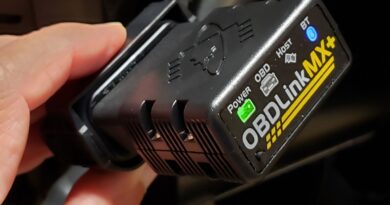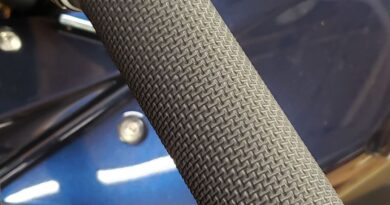Techniche Hyperkewl cooling vest
Given the extraordinary heat we’ve endured this summer, now is a great time to consider an effective and inexpensive way to reduce our suffering while riding through the elements. Plenty of fancy jackets feature broad mesh panels and/or zippered vents, and many of these are well-designed for maximizing airflow through the garment. However, even the best ventilation can only go so far in keeping a rider cool in severely hot conditions, when the wind feels as refreshing as being blasted with a giant blow-dryer. A growing number of apparel options are available for addressing this problem with superabsorbent materials which allow water to evaporate slowly over an extended timeframe. Such evaporative cooling augments or replaces the body’s natural method of coping with heat – sweating – and helps a rider stay cool and avoid dehydration, thereby improving comfort, mental clarity, and physical endurance. Netherlands-based Techniche’s Hyperkewl fabric is a particularly good example from this category. High-budget race teams use it and you can, too.
Early efforts by other manufacturers using related technology proved effective in amplifying/extending the benefits of evaporative cooling, but often came with significant drawbacks. They were bulky when dry and heavy when wet, and wearers were treated to an instant soaking as the garment encased their torsos with what felt like a sopping wet towel—not necessarily the worst sensation on the hottest rides, but certainly not ideal in general. The evolution of superabsorbent materials and one-way membrane permeability has allowed Techniche to deliver even better cooling without those original discomforts: Hyperkewl is light, thin, and (almost) dry to the touch throughout its interior. Nice.
I first discovered Hyperkewl in a snap/zip-in liner REV’IT! sold as an accessory for some of their vented jackets. Unfortunately, this product, called the Challenger Vest, is no longer for sale. When I got mine, having the cooling liner integral to the jacket seemed ideal, since there was only one item to don and remove, and the two didn’t move around independently to create bunching anywhere. After years of use, I’ve concluded these advantages are offset by two counterpoints: a) I can’t wear the vest alone or with non-REV’IT! gear, and b) the pre-ride soaking requirement means I still must take it out and put it back in each time I use it (five snaps and two zippers!). I was pleased to learn Techniche offers a variety of stand-alone Hyperkewl products, so I can still pass along this recommendation despite REV’IT! discontinuing the Challenger. Due to the slim, sleek Hyperkewl designs, bunching is actually quite unlikely, and being able to skip the uninstall/reinstall procedure—and use the vest with any ventilated jacket—makes non-dedicated Hyperkewl vests a better choice for most people, anyway. Perhaps best of all, they also now cost only $35-45, depending on model and vendor, making them less than half the price of my Challenger. Instead of the Challenger’s attachment hardware, the conventionally shaped stand-alone vests simply zip up the front.
Hyperkewl requires a quick two-minute soak in water prior to each use, followed by a gentle squeeze to remove excess fluid. This “charges” the polymer-embedded superabsorbent fibers, which are sandwiched between a blue, water-resistant, rip-stop interior layer and a black, ventilated outer layer that allows controlled evaporation. (The photo shows my Challenger; other color combinations are now available.) The interior layer minimizes contact between water and skin. There’s still a faint sensation of dampness, but nothing like the “slimy sponge” feel of more primitive designs/materials. The whole vest is breathable, and 3D mesh connecting its panels facilitates airflow around the torso. Because the superabsorbent fibers hold a considerable amount of water—Techniche says 20 times their volume—the vest does gain a bit of heft (about 1.5 pounds) when fully charged. Again, this is vastly superior to the wet blanket bulk of older cooling vests.

Once in place, the vest starts cooling its wearer immediately, even before wheels turn. Then, once air starts flowing through the jacket’s vents/mesh, it feels like that giant blow-dryer has been replaced with an air-conditioning unit—it really can be startlingly dramatic! Techniche claims the effect is equivalent to a 10-15-degree drop in ambient temperature. Although I have no way of verifying that with any objective measurement, I can vouch for it on a subjective basis—as long as the humidity isn’t extremely high, as it often is where I ride in the southeastern US. With temps and humidity both in the 90s, the effect is definitely diminished, but still quite noticeable and deeply appreciated.
Any evaporative cooling product (including our own sweat) works better when atmospheric humidity is lower, since the air isn’t already saturated with moisture and has more margin to receive heat-transferring vapor from nearby objects. In such conditions, Hyperkewl users will stay cooler, but for a shorter duration, as evaporation occurs more rapidly in drier air. Techniche claims their vests can remain effective for 5-10 hours; my experience has been more like 4-5. I’ve noticed a gradual reduction in cooling over the course of this timeframe, but have been content to pop the vest out and pour some fresh water on it when stopping for gas. To be fair, some cooling continues until the vest feels almost completely dry, but why not get the maximum benefit? If the effect fades before a ride is over, recharging the vest is easy to accomplish with any spigot or bottle of water.
I’ve especially valued my Hyperkewl vest on dual-sport rides, when I generated additional heat through physical exertion, but enjoyed little breeze because of low speeds (relative to street riding) and dense vegetation. The vest made the most of what airflow I could get. There have even been times when, once back on the road, I had to close my jacket vents to avoid a chill as temps dropped late in the day.
Techniche’s Hyperkewl vest is equivalent to my old Challenger. They also make a Hyperkewl Plus model with a mandarin collar instead of the standard version’s V-neck. All are available appropriately tailored for those of the female persuasion, and can be augmented with Hyperkewl neck- and wrist-wraps, as well as beanies for use inside vented helmets and shirts for other outdoor activities. These products don’t eliminate all the miseries of extreme heat, but they go a long way to improve comfort, preserve concentration, and avoid the health risks of hyperthermia.
For more information, visit techniche-intl.com.



